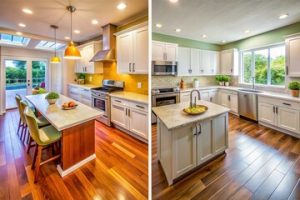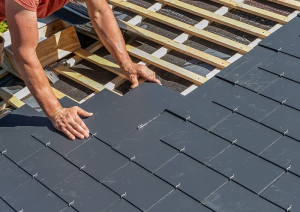Sacramento Cabinet Refacing allows homeowners to achieve a refreshed kitchen look without the high cost of full replacements. However, this project is intricate and requires advanced skills to perform properly.
DIY enthusiasts can save time and money by purchasing refacing kits, which provide the necessary materials in one convenient package. But these kits typically come with cheap products, resulting in a poor-quality job.

Cost
Cabinet refacing is an affordable way to update your kitchen without the expense of a complete renovation. It can save you up to 75% compared to full replacement costs. This makes it a budget-friendly alternative for homeowners looking to achieve a dramatic visual transformation in their homes without breaking the bank.
It’s also a more environmentally conscious option, as it conserves the existing structure and hardware while minimizing waste. Unlike replacing cabinets, which requires a new installation and often ends up with old materials in landfills, the original structures remain intact and can be reused. Additionally, the process minimizes the demand for raw materials and reduces the amount of wood that’s harvested from natural resources.
Another cost-effective advantage of cabinet refacing is that it’s less invasive than a complete renovation. Replacing cabinets involves extensive sanding and painting, which can create dust and disruption to your daily routine. With refacing, only the exterior surfaces are affected, and this can be completed in a few days. This allows you to enjoy your refreshed kitchen sooner.
When choosing a professional for cabinet refacing, it’s important to compare quotes to ensure you get the best value and avoid overpaying. Pricing can vary significantly depending on your location, labor rates, and the materials used. You can also find a number of online and wholesale suppliers that offer discounted prices on quality materials. However, beware of these sources since they often lack warranties and a professional installation service.
It’s possible to do cabinet refacing on your own, but this is a project that requires a lot of patience and precision. It’s not a project for the inexperienced DIYer, and even pros can make mistakes that could be costly to correct. Hiring a professional can ensure your project is done correctly the first time, saving you both time and money in the long run. And, if you do choose to go the DIY route, be sure to purchase high-quality tools and materials so that your efforts aren’t wasted by errors.
Time
Cabinet refacing is a fast, low-impact upgrade to your Vancouver home. This process saves you time and money by preserving your existing cabinet boxes and incorporating new doors and drawer fronts to create a fresh look. The new hardware also provides a sleek, finished appearance and adds convenience with features like soft-close hinges and slides. You can choose from modern metals such as nickel or classic choices like brass to complement your home’s aesthetic.
While cabinet refacing does not require the demolition and installation of new construction, it still requires significant labor hours. The project can take up to a week for professional installers, and homeowners often need to spend additional time preparing their homes for the work. The cost of removing and hauling away the old cabinetry also adds to project costs.
In addition, you must consider the materials used in the refacing process. Your choice of wood veneers, laminates, or other materials will impact price and durability. A professional can help you select a style that fits your budget while meeting your design goals.
Refacing is not a suitable option for structurally sound cabinets with water damage, rot, or other issues. The refacing process does not repair these areas, and you will need to address these problems if you plan to do a full replacement.
Homeowners often choose refacing as an alternative to a full kitchen remodel for the simple fact that it is less expensive. It’s important to remember that while refacing can save you money upfront, it does not address issues such as storage space or layout. If you need a more functional kitchen, it may be worth investing in a complete renovation.
Another benefit of refacing is that it reduces the amount of waste generated during a kitchen remodel. Refacing your existing cabinetry prevents perfectly usable materials from ending up in landfills, and it reduces resource consumption overall compared to full replacement. Refacing is a great option for Vancouver homeowners who want to reduce their environmental footprint while updating their kitchens.
Environment
Cabinet refacing is an eco-conscious alternative to replacing cabinets. By keeping the existing structure and merely updating the doors and hardware, it diverts perfectly usable materials from landfill overflow. Furthermore, since refacing requires fewer new raw materials than full replacements, it contributes to lower resource consumption. As a result, refacing can reduce carbon footprints, which is especially important if you’re concerned about the impact of your home improvement projects on the environment.
Refacing can also save you money on installation costs. This is because there’s no need for demolition or layout changes, which add up quickly when working on a large remodeling project. In addition, there’s usually no need to pay for labor or permits unless you’re removing and installing new fixtures. This can cut your overall remodel costs significantly, making it an excellent option for tight budgets.
However, refacing isn’t the right choice for every renovation. If your cabinet boxes are structurally damaged or you want to make significant layout changes, it might be necessary to invest in a full replacement. Additionally, refacing isn’t suitable for kitchen islands or other built-in features that require custom construction.
Cabinet refacing can last 10 or more years if it’s maintained properly, meaning that you can enjoy your refreshed look for a long time. This is much longer than the lifespan of new cabinets, which typically only last a few decades before they start to show signs of wear and tear.
While refacing is cheaper than replacement, it’s still a considerable investment. As such, you’ll want to weigh the pros and cons of each option carefully before committing to any project.
When deciding whether to reface or replace, consider your budget, timeline, and desired results. In most cases, refacing is the best option if your existing cabinets are in good shape structurally and have a functional layout. It’s also a great choice for homeowners who want to boost their home’s value with an updated kitchen, as newer cabinets are a major selling point for potential buyers.
Durability
When remodeling the kitchen, homeowners want to achieve a premium look without the higher costs of new cabinets. Cabinet refacing is an ideal solution that allows homeowners to choose from a wide selection of door styles, finishes, and hardware to create a personalized look that perfectly matches their home’s aesthetic.
Unlike a full replacement, refacing only involves the outer surfaces of the existing cabinet boxes, preserving the structural integrity of these structures. New cabinet doors and drawer fronts are then installed along with new hardware to completely transform the look of the cabinetry. Refacing also offers the opportunity to add modern features like soft-close hinges and slides.
In addition to reducing project costs, cabinet refacing is a more environmentally-conscious option than a complete remodel. Typical medium-density fiberboard (MDF) cabinets are discarded and end up in landfills, where they can leach harmful chemicals into the soil and groundwater. Refacing prevents these used materials from becoming trash and saves on new lumber use as well.
Cabinet refacing can be completed in a fraction of the time that a full remodel takes, minimizing project interruptions and keeping homeowners on track with their renovation schedules. With Eagle’s custom parts, most refacing projects can be completed in just three to five days. This fast turnaround helps contractors reduce jobsite time and protect their bottom lines in a competitive market.
The Cabinet Refacing Process
First, the existing cabinet face frames and sides are cleaned to remove dirt, grease, and other impurities that can interfere with the adhesion of the new material. The exposed surfaces of the face frames are then sanded and repaired as needed to ensure a smooth surface for the application of new veneer or laminate. Next, the cabinet boxes are primed and lightly sanded to help ensure a smooth finish. Finally, the new laminate or wood veneer is applied to the face frames and sides. A final coat of sealant is then applied to the face frames to provide a protective barrier against daily wear and tear. The finished product is a dramatic transformation of the entire cabinet structure that can be complemented with crown molding and other decorative trims as desired.
